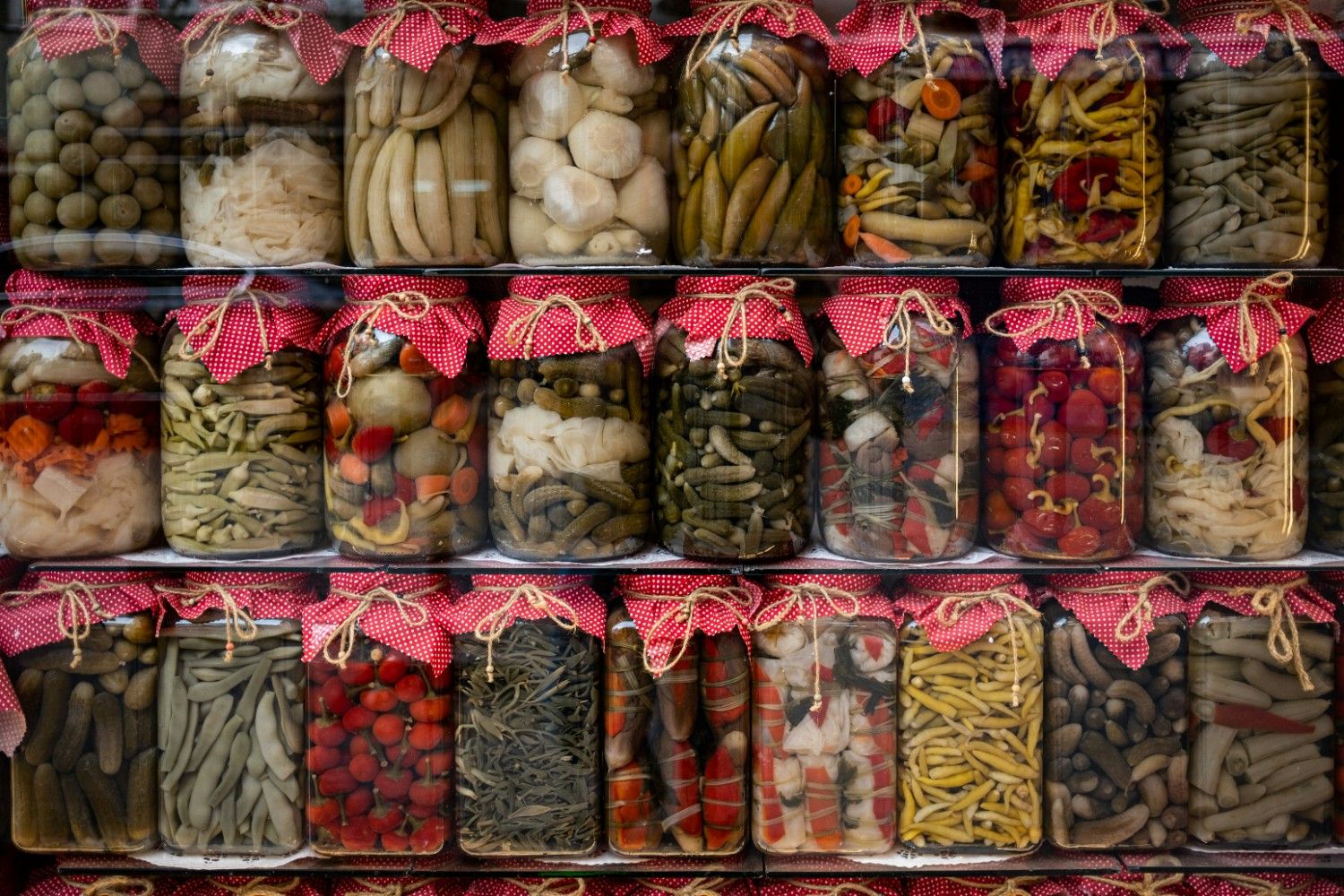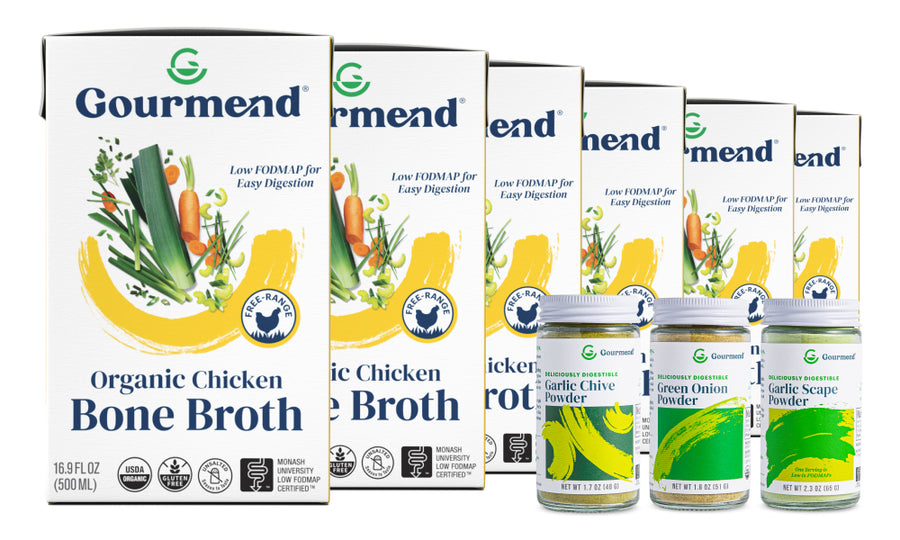Are Pickles Low FODMAP? Your Complete Guide to Safe Eating

What Are FODMAPs and Why They Matter for Your Digestive Health
If you're navigating digestive sensitivities, you've likely encountered the term "FODMAP" and wondered what it means for your favorite foods. FODMAPs—short for Fermentable Oligo-, Di-, Mono-saccharides, and Polyols—are specific types of carbohydrates that can trigger digestive discomfort in sensitive individuals.
Key Takeaways
- FODMAPs are types of carbohydrates that can cause digestive discomfort in sensitive individuals.
- The term FODMAP stands for Fermentable Oligo-, Di-, Mono-saccharides, and Polyols.
- Understanding FODMAPs is important for managing digestive sensitivities.
Table of Contents
- What Are FODMAPs and Why They Matter for Your Digestive Health
- Understanding the Low FODMAP Diet Structure
- How the Pickling Process Affects FODMAP Content
- Are Cucumbers Low FODMAP?
- Pickles and Low FODMAP Considerations
- Making Low FODMAP Pickles at Home
- Safely Introducing Pickles on a Low FODMAP Diet
- Store-Bought vs. Homemade Pickle Considerations
Key Fact: Research shows that up to 86% of people with IBS experience symptom improvement when following a low FODMAP diet under proper guidance.
These short-chain carbohydrates resist digestion in the small intestine, traveling to the colon where gut bacteria ferment them rapidly. This fermentation process produces gas and draws water into the intestines, potentially causing bloating, cramping, and other uncomfortable symptoms.
Understanding individual FODMAP tolerance is crucial because sensitivity varies dramatically from person to person. What triggers symptoms in one individual might be perfectly tolerable for another—making personalized testing essential for long-term success.
Quick Answer
Yes, most pickles are low FODMAP when consumed in moderate servings (around 2 tablespoons or 28g). However, you must check ingredient labels carefully, as many commercial pickles contain high FODMAP ingredients like garlic bulbs or onion bulbs that can trigger digestive symptoms.
Understanding the Low FODMAP Diet Structure
The low FODMAP diet isn't a permanent restriction—it's a systematic three-phase approach designed to identify your personal trigger foods while maintaining nutritional balance and flavor satisfaction.
Phase 1: Elimination (2-6 weeks)
During this initial phase, you temporarily remove high FODMAP foods from your diet while focusing on low FODMAP alternatives. This phase allows your digestive system to settle and establishes a symptom baseline.
Phase 2: Reintroduction (6-10 weeks)
You systematically reintroduce specific FODMAP groups one at a time, monitoring your body's response. This phase reveals which FODMAPs you can tolerate and in what quantities.
Phase 3: Maintenance (Ongoing)
Based on your reintroduction results, you create a personalized eating plan that includes your tolerated foods while avoiding confirmed triggers.
Benefits of the Low FODMAP Approach
- Evidence-based relief for IBS and SIBO symptoms
- Maintains dietary variety through personalized tolerance testing
- Preserves gut microbiome diversity when properly implemented
- Provides clear framework for identifying trigger foods
Considerations
- Requires careful planning and label reading
- May need professional guidance for optimal results
- Temporary restriction period can feel challenging initially
- Individual tolerance varies significantly
The diet's effectiveness in managing IBS symptoms stems from reducing the overall FODMAP load in your digestive system. By minimizing fermentable carbohydrates, you decrease gas production and water retention in the intestines, leading to improved comfort and digestive function.
How the Pickling Process Affects FODMAP Content
When evaluating whether pickles fit into your low FODMAP lifestyle, understanding how fermentation and pickling impact FODMAP levels becomes essential. The pickling process can actually alter the FODMAP content of foods in unexpected ways.
"The pickling process can cause fructose to leach from cucumbers into the brine, potentially concentrating FODMAPs in the liquid while reducing them in the vegetable itself," explains digestive health research.
Fresh cucumbers are naturally low FODMAP in servings up to 75g (about 1/2 cup), making them an excellent base for pickled products. However, the transformation from cucumber to pickle involves several factors that affect FODMAP content:
- Ingredient additions: Commercial pickles often contain garlic-chive stems, chive sprigs, or other aromatics that can impact FODMAP levels
- Fermentation time: Longer fermentation periods may reduce certain FODMAPs while concentrating others
- Brine composition: The pickling liquid can absorb fructose from the cucumbers during processing
- Serving size: Even low FODMAP pickles can become problematic in large quantities
Critical for Success: Always check ingredient labels for high FODMAP additions like garlic bulbs, onion bulbs, or high fructose corn syrup. These ingredients can transform an otherwise low FODMAP pickle into a trigger food.
For optimal digestive comfort, we recommend starting with small servings—about 2 tablespoons or 28g—and monitoring your individual response. This approach allows you to enjoy the tangy, satisfying crunch of pickles while respecting your digestive boundaries.
At Gourmend Foods, we understand that navigating these nuances can feel overwhelming. That's why we've developed resources to help you confidently incorporate flavorful, gut-friendly ingredients into your cooking. Our low FODMAP recipe collection includes creative ways to use pickles and other fermented foods safely within your dietary framework.
Are Cucumbers Low FODMAP?

Yes, cucumbers are generally low FODMAP in servings up to 75g (approximately 1/2 cup or about 10 cucumber slices). This makes them an excellent foundation for pickled products, though the final FODMAP content depends on additional ingredients and processing methods.
Serving Size Guideline: Fresh cucumbers remain low FODMAP up to 75g per serving, but individual tolerance may vary during the elimination phase of your low FODMAP journey.
The cucumber's naturally low FODMAP profile stems from its high water content and minimal concentration of fermentable carbohydrates. Unlike many vegetables that contain significant amounts of fructans or polyols, cucumbers primarily consist of water, fiber, and small amounts of natural sugars that don't typically trigger digestive symptoms.
Different Cucumber Varieties and Their FODMAP Levels
Understanding how different cucumber varieties affect your digestive comfort helps you make informed choices when selecting pickles or preparing homemade versions:
- Continental cucumbers: Standard grocery store variety, well-tested at 75g serving size
- Lebanese cucumbers: Smaller, crunchier texture, same FODMAP guidelines apply
- Gherkins: Tiny cucumbers often used for pickling, limited upper serving data available
- Cucamelons: Grape-sized cucumber relatives, consume in moderation due to limited testing
Important Note: While most cucumber varieties share similar FODMAP profiles, gherkins and specialty varieties have limited research on upper serving limits. Start with smaller portions when trying new varieties.
The consistent low FODMAP status across cucumber varieties makes them reliable ingredients for gut-friendly cooking. Whether you're enjoying fresh cucumber salads or exploring pickled options, you can feel confident incorporating these versatile vegetables into your meal planning.
Pickles and Low FODMAP Considerations
The transformation from cucumber to pickle involves more than simple preservation—it's a complex process that can significantly impact FODMAP content. While the cucumber base remains low FODMAP, commercial pickling often introduces ingredients that can trigger digestive symptoms in sensitive individuals.
"The biggest challenge with commercial pickles isn't the cucumber itself, but the flavor enhancers added during processing. Garlic bulbs and onion bulbs are common culprits that can turn a gut-friendly snack into a trigger food."
How Pickling Affects FODMAP Levels
During the pickling process, several changes occur that influence the final FODMAP content of your pickles:
FODMAP-Friendly Changes
- Fermentation can break down some FODMAPs over time
- Cucumber base remains naturally low FODMAP
- Vinegar and salt don't contribute FODMAPs
- Proper herbs like dill and chives add flavor safely
Potential FODMAP Increases
- Fructose may concentrate in the pickling brine
- Added sweeteners can introduce excess fructose
- Garlic and onion flavoring creates high FODMAP content
- Some preservatives contain problematic ingredients
The pickling liquid itself deserves special attention. As cucumbers sit in brine, natural sugars including fructose can leach into the liquid. This process potentially concentrates FODMAPs in the brine while reducing them in the cucumber flesh. For this reason, consuming large amounts of pickle juice may trigger symptoms even when the pickles themselves are well-tolerated.
Guidelines for Safe Pickle Consumption
Successfully incorporating pickles into your low FODMAP lifestyle requires attention to both ingredient selection and portion control. Start with small servings—about 2 tablespoons or 28g—and monitor your individual response over several days.
Pickle Serving Guidelines
- Starting portion: 2 tablespoons (28g)
- Frequency: Once daily during elimination phase
- Timing: With meals to slow digestion
- Monitoring: Track symptoms for 24-48 hours
Individual tolerance varies significantly, making personal testing essential. Some Gourmend customers find they can enjoy larger servings without discomfort, while others prefer to keep pickles as occasional flavor accents rather than regular snacks.
For optimal success, consider exploring our low FODMAP recipe conversion tool to discover creative ways to incorporate pickles and other fermented foods into your favorite dishes while maintaining digestive comfort.
If you're looking for additional perspectives on the question are pickles low FODMAP, this external resource provides a detailed breakdown of FODMAP content in various pickled products.
Making Low FODMAP Pickles at Home

Quick Answer
Yes, pickles can be low FODMAP when made without high FODMAP ingredients like garlic bulbs and onion bulbs. Store-bought pickles often contain these trigger ingredients, but homemade versions using cucumbers, vinegar, salt, and low FODMAP herbs like dill and chives are perfectly safe for most people following a low FODMAP diet.
Creating your own low FODMAP pickles transforms a potentially problematic snack into a gut-friendly staple. The beauty of homemade pickles lies in complete ingredient control—you decide exactly what goes into your brine, eliminating the guesswork that comes with commercial products.
"We've found that making pickles at home isn't just about avoiding trigger ingredients—it's about creating flavors that rival gourmet delicatessens while supporting your digestive health journey."
Essential Low FODMAP Pickle Ingredients
The foundation of excellent low FODMAP pickles starts with selecting the right ingredients. Each component serves a specific purpose in creating that perfect balance of tang, crunch, and flavor:
- Mini cucumbers: Ideal size for quick pickling, consistent texture
- Distilled white vinegar: Provides acidity without FODMAPs
- Kosher salt: Essential for proper brining and preservation
- Dried chives: Delivers onion-like flavor safely
- Fresh dill: Classic pickle herb, naturally low FODMAP
- Black peppercorns: Adds gentle heat and complexity
Pro Tip: Use filtered water for your brine to avoid chlorine flavors that can interfere with the fermentation process and overall taste.
The key to successful low FODMAP pickles lies in understanding how each ingredient contributes to both flavor and digestive comfort. Unlike commercial varieties that rely on garlic bulbs and onion bulbs for depth, we achieve complex flavors through careful layering of approved herbs and spices.
Quick Low FODMAP Pickle Recipe
This simple method produces crisp, flavorful pickles ready to enjoy within hours. The quick-pickle technique bypasses lengthy fermentation while delivering that signature tangy crunch:
- Prepare the brine: Combine 1 cup distilled white vinegar, 1 cup water, and 1 tablespoon kosher salt in a saucepan
- Heat and dissolve: Bring mixture to a boil, stirring until salt completely dissolves
- Add aromatics: Stir in 1 teaspoon dried chives and 1/2 teaspoon black peppercorns
- Pack cucumbers: Place 1 pound sliced mini cucumbers and 2 fresh dill sprigs in clean jar
- Pour hot brine: Cover cucumbers completely with hot brine mixture
- Cool and refrigerate: Let cool to room temperature, then refrigerate for minimum 2 hours
This recipe yields approximately 16 servings at the recommended 2-tablespoon portion size. The pickles improve in flavor over the first 24 hours and maintain optimal texture for up to two weeks when properly refrigerated.
For more inspiration on how to use your homemade pickles, check out our collection of low FODMAP recipes featuring creative, gut-friendly dishes.
Safely Introducing Pickles on a Low FODMAP Diet
Successfully incorporating pickles into your low FODMAP lifestyle requires a strategic approach that prioritizes individual tolerance while maximizing flavor enjoyment. The elimination phase demands particular caution, as your digestive system may be more sensitive during this foundational period.
Pickle Introduction Strategy
- Week 1: Test 1 tablespoon serving with lunch
- Week 2: Increase to 2 tablespoons if well-tolerated
- Week 3: Try different meal timing or frequency
- Week 4: Establish personal serving limit
Timing plays a crucial role in pickle tolerance. Consuming pickles alongside meals containing protein and healthy fats can slow digestion and reduce the likelihood of rapid FODMAP absorption. This approach proves especially beneficial for individuals with heightened sensitivity during their elimination phase.
Monitoring Your Individual Response
Personal tolerance varies dramatically among individuals following a low FODMAP diet. Some Gourmend customers report enjoying larger servings without discomfort, while others find success with pickles as occasional flavor accents rather than regular snacks.
Remember: Digestive symptoms can appear 4-24 hours after consumption. Track your response over multiple days before increasing serving sizes or frequency.
Keep a detailed food and symptom diary during your pickle introduction period. Note not just immediate reactions, but also energy levels, sleep quality, and overall digestive comfort. This comprehensive approach helps identify patterns that pure symptom tracking might miss.
Consider exploring our low FODMAP recipe collection for creative ways to incorporate pickles into complete meals that support your digestive wellness journey.
For a deeper dive into the science and practical tips on introducing pickles, you may also want to read this evidence-based article from a registered dietitian: are pickles low FODMAP.
Store-Bought vs. Homemade Pickle Considerations
The choice between commercial and homemade pickles significantly impacts both FODMAP content and overall digestive comfort. While convenience favors store-bought options, ingredient control makes homemade versions the gold standard for sensitive individuals.
Homemade Pickle Advantages
- Complete ingredient control eliminates FODMAP guesswork
- Customizable flavor profiles suit individual preferences
- No preservatives or artificial additives
- Cost-effective for regular consumption
Store-Bought Pickle Challenges
- Hidden garlic and onion ingredients common
- Artificial flavoring may contain FODMAPs
- Preservatives can trigger sensitivities
- Limited low FODMAP commercial options
Commercial pickle manufacturers frequently use garlic bulbs and onion bulbs as primary flavoring agents, making most mainstream brands unsuitable for strict low FODMAP adherence. Even "natural" varieties often contain these trigger ingredients in powder or extract form.
Identifying Safe Commercial Pickle Options
When homemade pickles aren't practical, careful label reading becomes essential. Look for products with minimal ingredient lists featuring only cucumbers, vinegar, salt, water, and approved herbs like dill or mustard seeds.
Label Reading Tips: Avoid products listing "natural flavors," "spices," or "seasoning" without specific ingredient disclosure, as these terms often mask high FODMAP ingredients.
The fermentation process in some commercial pickles can actually reduce FODMAP content over time, but this benefit gets overshadowed when manufacturers add problematic ingredients during processing. This reality makes ingredient transparency more important than fermentation benefits.
Whether you choose homemade or carefully selected commercial pickles, remember that individual tolerance remains the ultimate guide. Start conservatively, monitor your response, and adjust accordingly. The goal isn't perfect adherence to arbitrary rules—it's finding an approach that supports your digestive comfort while allowing you to enjoy the foods you love.
For additional guidance on navigating ingredient challenges and creating gut-friendly meals, explore our comprehensive recipe conversion tool designed specifically for low FODMAP cooking success.
If you're interested in expanding your knowledge of FODMAPs and digestive health, our learn section offers in-depth articles and resources to support your journey.
Check out our Low Fodmap Bundles
Frequently Asked Questions
Which pickles are low in FODMAP?
Pickles made from cucumbers, vinegar, salt, and low FODMAP herbs or spices like dill, chive sprigs, or mustard seeds are typically low FODMAP. Avoid pickles that include high FODMAP ingredients such as garlic or onion bulbs. Always check labels for added sugars or flavorings that might introduce FODMAPs.
Can I eat pickles with IBS?
Yes, many people with IBS can enjoy pickles made with low FODMAP ingredients without triggering symptoms. Because pickling uses vinegar and salt, it preserves cucumbers in a way that keeps them gentle on digestion. However, portion size matters, and it’s best to avoid pickles with high FODMAP additives like garlic or onion.
Are Vlasic dill pickles low FODMAP?
Vlasic dill pickles often contain garlic and onion derivatives, which are high FODMAP and can cause digestive discomfort. Unless the label specifically states they are made without these ingredients, they are unlikely to be low FODMAP. Choosing pickles made with simple, transparent ingredients is a safer bet for gut health.
Does pickling remove FODMAPs?
Pickling does not remove FODMAPs from the vegetables themselves; it primarily preserves and flavors them. High FODMAP ingredients like garlic or onion retain their FODMAP content even after pickling. That’s why selecting pickles free from these ingredients is key to keeping them low FODMAP.
Are pickles gut friendly?
Pickles can be gut friendly when made with low FODMAP ingredients because they provide flavor without triggering digestive upset. Additionally, naturally fermented pickles contain probiotics that may support gut health, but commercially pickled cucumbers often use vinegar instead of fermentation, so probiotic benefits vary. Always opt for clean-label pickles to ensure they align with your digestive needs.
Is coffee low in FODMAP?
Coffee itself is low FODMAP in moderate amounts and usually well tolerated by people managing IBS. However, coffee is acidic and can sometimes irritate sensitive digestive systems, so individual tolerance varies. Avoid adding high FODMAP ingredients like dairy creamers or syrups to keep your coffee gut-friendly.





